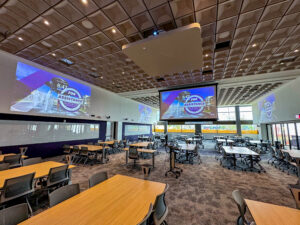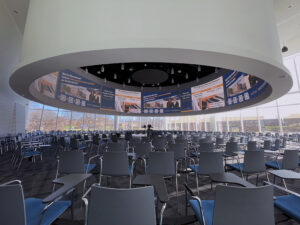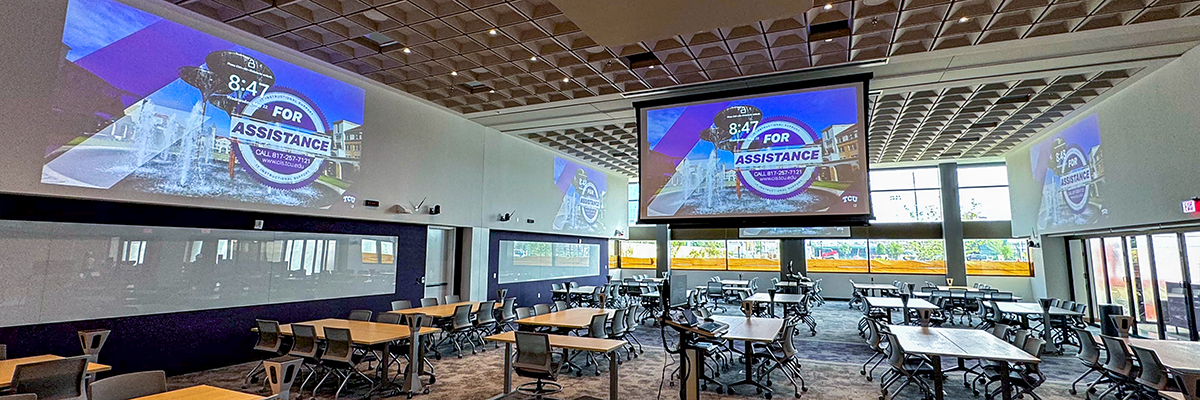By John Cook, CTS, Senior Vice President, Technology & Acoustics Group, NV5
For the last two decades, many colleges and universities have embraced active learning as a core pedagogical strategy. Classrooms have evolved from didactic, lecture-driven spaces into flexible, tech-rich active environments that support small-group collaboration, flipped instruction, and experiential learning. But now, Artificial Intelligence (AI) is the new force in reshaping the learning landscape.
AI isn’t replacing active learning but rather enhancing it with personalization, real-time feedback, and intelligent systems. As AI reshapes how students learn, and how faculty teach, conduct research, and prepare curricular materials, it also reshapes how the design community considers the “Three S Model” of Systems, Spaces, and Services.
This is an emerging area of study, and we now only see the proverbial tip of the iceberg. Below are some early impressions of how AI will influence the next generation of learning environments in higher education and drive a new wave of innovation in instructional technology design and architectural planning.
Of course, there are many challenges in making the below a reality anytime soon, but the following should influence the thinking around new academic spaces.
1. From Flexible to Responsive: AI and Spatial Intelligence

Many Active Learning Classrooms are already “flexible” and feature reconfigurable furniture, multiple display zones, flexible tech systems, and collaborative pods. AI introduces a new layer: spatial responsiveness.
Future AI-integrated classrooms will:
- Adjust environmental conditions (lighting, HVAC, acoustics) based on occupancy and activity.
- Track engagement using computer vision and audio analytics to inform instructional strategies.
- Optimize layouts through data-driven analysis of how students move, cluster, and interact.
Ideally, classrooms should be flexible and adaptable enough to be reprogrammed for different instructional modes, enhanced by AI and responsive systems. Architecturally, this means designing spaces with embedded sensors, edge computing nodes, and IoT infrastructure. (But please don’t limit your vision to the “Smart Building” conversations over the past 15 years or so, as AI will turbo-charge all of those ideas.) Raised access floors, pipe grid ceilings, networked ceilings, and modular wall systems become essential for future-proofing. My predecessor at NV5 (formerly The Sextant Group), Mark Valenti, wrote about the concept of “Black Box Classrooms” over 20 years ago, and his vision gets closer to reality with each AI development.
2. Personalized Learning at Scale
AI enables individualized learning pathways, where students receive tailored content, pacing and feedback, even in group settings. OpenAI recently released “study mode” in its chatbot, leveraging the Socratic method to create study plans, customized quizzes, and generally act like a tutor to be used alongside other learning resources. Google responded with a similar offering, and you can expect to see other similar developments coming.
This requires:
- Device-agnostic connectivity: Classrooms should support seamless integration of laptops, tablets, wearables, and AR/VR headsets.
- Instructional software platforms: These platforms should deliver predictive analytics and other data-driven insights to faculty in real-time.
- Data privacy zones: As students interact with AI tutors or analytics dashboards, they need semi-private spaces for focused, personalized engagement.
- Instructor visibility: Faculty need real-time dashboards that aggregate student progress and identify needs for intervention.
Architectural responses include micro-environments within larger rooms, adjustable lighting and acoustics, and display clusters for differentiated instruction.
3. AI and the Evolution of Hybrid Learning

Hybrid and hyflex models are now standard at many institutions. AI enhances these models by:
- Automating camera tracking and audio mixing for seamless remote participation.
- Generating summaries and transcripts for asynchronous learners.
- Analyzing participation patterns, encouraging instructors to improve equity and engagement.
- Extending interactive surfaces such touchscreens, writable walls, and digital annotation tools to integrate with AI platforms.
This pushes classroom design toward broadcast-quality AV systems, AI-enhanced microphone arrays (mic the student areas, not just the presenter, please!), writable walls, and optimized lighting, sightlines, and acoustics. Room designs and furnishings should account for visual framing to help shape perception and influence behavior, promoting teamwork at times and self-study at others.
4. AI-Enhanced Multimodal Learning
AI enhances multimodal learning through dynamic, adaptive media rather than static content delivery.
These include real-time transcription and translation for multilingual or hearing-impaired learners, AI-generated visualizations that respond to student questions or data inputs with tailored information, and voice-activated interfaces that allow students to interact with content hands-free. Multiple AI-generated scenarios and problems help facilitate positive learning transfer.
Classrooms should be reimagined for different instructional modes, enhanced by AI and responsive systems Instructional technology design should support low-latency AV switching, cloud-based rendering, voice-activated control systems, and (possibly) AI middleware that integrates with LMS platforms and classroom control systems. Classroom control systems should not be limited to pre-configured options and/or primitive programming tools often associated with some AV control systems.
Architects must consider acoustic zoning, display sightlines, multiple camera views, and ambient lighting that supports both human and machine vision.
5. AI-Driven Assessment and Feedback
Traditional assessment is evolving into continuous, formative feedback loops powered by
This requires:
- Data capture infrastructure: classrooms must support secure data collection, edge processing, cloud syncing, and seamless sharing of information.
- Feedback zones: Spaces where students can review AI-generated feedback individually or in small groups. Privacy may be required in some situations.
Architects should respond with tech-integrated furniture, privacy pods, and proper acoustic environments.
6. Equity, Accessibility, and AI
If designed intentionally, AI has the potential to enhance accessibility and reduce barriers to learning. Tools such as real-time captioning, adaptive interfaces, and emotion-aware feedback can support diverse learners.
Design responses include:
- Inclusive AV systems: Captioning displays, assistive listening devices, and voice-controlled interfaces.
- Sensory-friendly spaces: Zones with adjustable lighting, acoustic dampening, and minimal visual clutter.
- Wayfinding and navigation: AI-powered kiosks and mobile apps that guide students through complex buildings.
Instructional technologists should ensure universal design for learning (UDL) principles are embedded in AI tools, while architects should create environments that are sensory-inclusive.
7. Campus Planning and AI
The impact of AI on higher ed campuses is not confined to the classroom; it should be an
This calls for interdisciplinary collaboration between architects, IT, facilities, and academic leadership to design campuses as intelligent ecosystems, with data interoperability, cybersecurity, and scalable infrastructure at the core.
Final Thoughts
AI is not a temporary or incremental tech development, nor a disruption to learning and scholarship. It is the next layer of evolution. It builds on decades of pedagogical and technological innovation and challenges us to design spaces that are not just flexible, but responsive, intelligent, and inclusive.
For instructional technologists, it means integrating AI tools that enhance (not replace!) human teaching and learning. For architects, this means embracing the new opportunities and adapting design to accommodate them.
The future of higher education will be shaped by how we align pedagogy with the Systems, Spaces, and Services. And AI is the catalyst pushing that alignment to new heights.
(Note: this article was written with the help of AI, of course. While many of the ideas here are original, they were refined and wordsmithed by AI in a fraction of the time that would have otherwise been required.)
John Cook, CTS is the Senior Vice President of the Technology & Acoustics group of NV5, and a nationally recognized expert on the intersection of pedagogy and instructional technologies.

